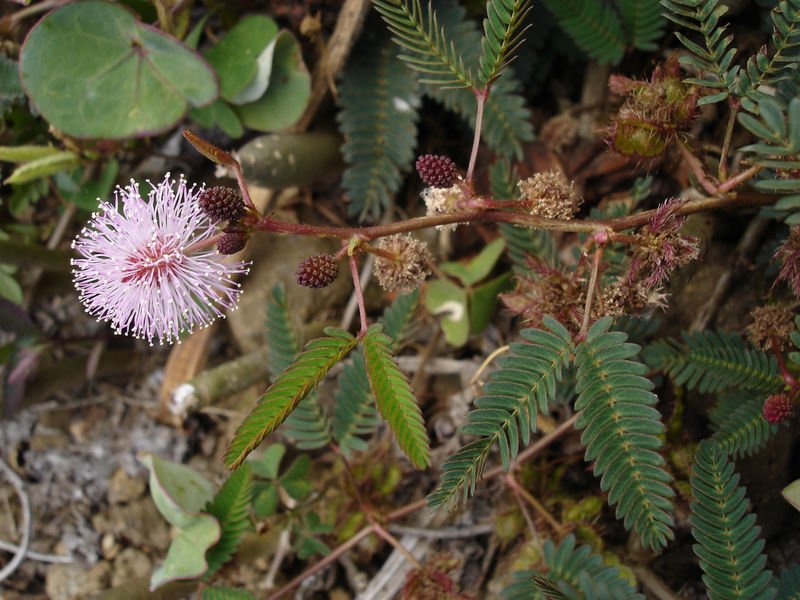|
TRANSLATIONS
Now I think I know why my subconscious mind is playing tricks on me: It is preparing me for next 'chapter' in the glyph dictionary, toa. ... The upside down hanging victims (rau hei, mimosa branches) may be Easter Island 'decorations' of the same kind as those called ra'a nu'u, sacredness (ra'a) of the host (nu'u) on Tahiti, beautiful offers to the gods.
The Sensitive plant (Mimosa pudica L.) is a creeping annual or perennial herb often grown for its curiosity value: the compound leaves fold inward and droop when touched, re-opening within minutes. Mimosa pudica is native to Brazil, but is now a pantropical weed. Other names given to this curious plant are Humble plant, TickleMe Plant, Shame plant, Sleeping grass, Prayer Plant, Touch-me-not, Makahiya (Philippines, meaning 'shy'), Mori Vivi (West Indies), mate-loi (false death) (Tonga). The Chinese name for this plant translates to 'shyness grass'. The species epithet, pudica, is Latin for 'bashful' or 'shrinking', because of its curious nature and easy procreation. Its Sinhala name is Nidikumba, where 'nidi' means 'sleep'. The seeds are currently marketed to children under the name 'TickleMe Plant'. The stem is erect in young plants, but becomes creeping or trailing with age ... In the evening the leaflets will fold together and the whole leaf droops downward. It then re-opens at sunrise ... The 'mimosa branches' (rau hei) glyphs are fully alive, but acting as if dead. Kb3-12 and Kb3-15 have not been classified as rau hei in my catalogue:.
52 keeps propping up. In G we had 252 and 352:
With the pattern of moon coming before sun (Ga6-22 respectively Ga6-25), we will understand Gb1-22 as relating to moon, while Gb1-25 will be relating to sun. Comparing Gb1-25 with Gb5-1 suggests that Gb1-24 corresponds to Gb4-33 - i.e. the tao glyph type represents new life (light) and rau hei light in descending. The rising fish in Gb4-32 must be moon-related, yet hua in Gb4-30 is hanging in front, not as in the Mamari moon calendar:
Kb3-12 (3 * 12 = 360) seems to be a combination between the sun type of rau hei (with a forward male limb) and the type of glyph which Gb8-30 exemplifies (a 'closed' variant of pu), and which also appears at the beginning of the K text:
I have not listed any rau hei glyphs under K in the catalogue. But now I will put Kb3-12 there. By the way, I have to catch an idea in flight. The Black Rat, Te Kioe Uri, together with the other glyphs in G which represent kuhane stations, probably - I think - are drawn to draw attention, they are 'marked'. Two examples:
Neither 60 nor 444 are divisible by 29.5 but 2 * 29.5 = 59 and 15 * 29.5 = 442.5, close enough for enabling us to identify the glyphs as referring to Te Kioe Uri respectively to One Tea. In Ga2-29 the circumference is not broken anywhere - the upside down 'ariki' is a kind of rau hei - in Gb8-2 henua is no longer 'living'. In this perspective we can identify Kb4-11 as the same 'person' as The Black Rat - on the verge of being turned upside down in the 'recycling station':
The parallel Ga7-6, on the other hand, is a 'ghost' with 'feathers' on top of his head. I have two more rau hei glyphs listed under G:
To show where they are located I will give the whole 'chapter'. It is not easy to know where to begin, but Sirius followed by tao (Gb2-12) says the new season begins here:
|
||||||||||||||||||||||||||||||||||||||||||||||||||||||||||||||||||||||||||||||||||||||||||||||||||||||||||||||||||||||||||||||||||||||||||||||||||||||||||||||||||||||||||||||||||||||||||||||||||||||||||||||||||||||||||||||||||||||||||||||||||||||||||||||||||||||








































